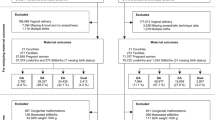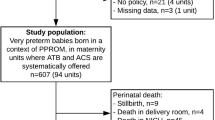Abstract
Objectives
To understand clinicians’ consensus on mode of delivery in extremely preterm breech infants; assess knowledge on neonatal outcomes and its impact on consensus.
Study design
A two-round Delphi of obstetrical or neonatal care providers, recruited from national conferences and investigator networks. Round one assessed decision-making (vignettes), and knowledge; the second round reassessed vignettes after presenting outcome data.
Results
In round one (102 respondents), consensus (a priori, ≥75% agreement) was achieved in 4/13 vignettes: two when likely/very likely to offer Cesarean (26 and 27 weeks) and two for unlikely/very unlikely (23 weeks growth restriction, ± adverse features). Clinicians generally underestimated neonatal outcomes. In round two (87 respondents), three scenarios achieved consensus (likely/very likely to offer Cesarean at 25–27 weeks); in five other vignettes, not offering Cesarean was reduced in ≥15% of respondents.
Conclusion
Limited consensus exists on extremely preterm breech mode of delivery, partly associated with neonatal outcome underestimation.
Gestational age notation
The authors follow the World Health Organization’s notation on gestational age. Under this notation, the first day of the last menstrual period (LMP) is day 0 of week 0. Therefore, days 0–6 represent completed week 0, days 7–13 represent completed week 1 and so on.
This is a preview of subscription content, access via your institution
Access options
Subscribe to this journal
Receive 12 print issues and online access
$259.00 per year
only $21.58 per issue
Buy this article
- Purchase on Springer Link
- Instant access to full article PDF
Prices may be subject to local taxes which are calculated during checkout



Similar content being viewed by others
Data availability
The datasets generated and/or analyzed during the current study are available from the corresponding author on reasonable request.
References
WHO. Preterm birth fact sheet. World Health Organization; 2018.
Hickok DE, Gordon DC, Milberg JA, Williams MA, Daling JR. The frequency of breech presentation by gestational age at birth: a large population-based study. Am J Obstet Gynecol. 1992;166:851–2.
Grabovac M, Karim J, Isayama T, Liyanage SK, McDonald S. What is the safest mode of birth for extremely preterm breech singleton infants who are actively resuscitated? A systematic review and meta-analyses. BJOG. 2018;125:652–63.
Moramarco V, Liyanage SK, Ninan K, Mukerji A, McDonald SD. Classical cesarean: what are the maternal and infant risks compared with low transverse cesarean in preterm birth, and subsequent uterine rupture? A systematic review and meta-analysis. J Obstet Gynaecol Can. 2020;42:179–97. e3.
Diamond IR, Grant RC, Feldman BM, Pencharz PB, Ling SC, Moore AM, et al. Defining consensus: a systematic review recommends methodologic criteria for reporting of Delphi studies. J Clin Epidemiol. 2014;67:401–9.
Beiderbeck D, Frevel N, Heiko A, Schmidt SL, Schweitzer VM. Preparing, conducting, and analyzing Delphi surveys: cross-disciplinary practices, new directions, and advancements. MethodsX. 2021;8:101401.
Boulkedid R, Abdoul H, Loustau M, Sibony O, Alberti C. Using and reporting the Delphi method for selecting healthcare quality indicators: a systematic review. PLoS ONE. 2011;6:e20476.
van Vliet DC, van der Meij E, Bouwsma EV, Vonk Noordegraaf A, van den Heuvel B, Meijerink WJ, et al. A modified Delphi method toward multidisciplinary consensus on functional convalescence recommendations after abdominal surgery. Surg Endosc. 2016;30:5583–95.
Hasson F, Keeney S, McKenna H. Research guidelines for the Delphi survey technique. J Adv Nurs. 2000;32:1008–15.
Statistics Division - Economic and Social Commission for Asia Pacific Region. Guidelines for cognitive and pilot testing of questions for use in surveys. 2010. https://wwwn.cdc.gov/qbank/report/WashingtonGroup_NCHS_2010_ESCAP.pdf.
Okoli C, Pawlowski SD. The Delphi method as a research tool: an example, design considerations and applications. Inf Manag. 2004;42:15–29.
Canadian Neonatal Network. Annual report 2017. 2017; http://www.canadianneonatalnetwork.org/Portal/LinkClick.aspx?fileticket=XhPMIxFgc2M%3d&tabid=39.
Ding S, Lemyre B, Daboval T, Barrowman N, Moore GP. A meta-analysis of neurodevelopmental outcomes at 4-10 years in children born at 22-25 weeks gestation. Acta Paediatr. 2019;108:1237–44.
Serenius F, Ewald U, Farooqi A, Fellman V, Hafström M, Hellgren K, et al. Neurodevelopmental outcomes among extremely preterm infants 6.5 years after active perinatal care in Sweden. JAMA Pediatr. 2016;170:954–63.
Zlatohlávková B, Kytnarová J, Kuběna A, Fleischnerová A, Dokoupilová M, Plavka R. Five-year survival without major disability of extremely preterm infants born at 22-27 weeks’ gestation admitted to a NICU. Acta Paediatr. 2010;99:1618–23.
Hall DA, Smith H, Heffernan E, Fackrell K, Core Outcome Measures in Tinnitus International Delphi Research Steering Group. Recruiting and retaining participants in e-Delphi surveys for core outcome set development: evaluating the COMiT’ID study. PLoS ONE. 2018;13:e0201378.
Stiggelbout AM, Pieterse AH, De Haes JC. Shared decision making: concepts, evidence, and practice. Patient Educ Couns. 2015;98:1172–9.
Doucette S, Lemyre B, Daboval T, Dunn S, Akiki S, Barrowman N, et al. Effect of an educational presentation about extremely preterm infants on knowledge and attitudes of health care providers. Am J Perinatol. 2017;34:0982–9.
Kaempf JW, Tomlinson M, Arduza C, Anderson S, Campbell B, Ferguson LA, et al. Medical staff guidelines for periviability pregnancy counseling and medical treatment of extremely premature infants. Pediatrics. 2006;117:22–9.
Morse SB, Haywood JL, Goldenberg RL, Bronstein J, Nelson KG, Carlo WA. Estimation of neonatal outcome and perinatal therapy use. Pediatrics. 2000;105:1046–50.
Boland RA, Davis PG, Dawson JA, Doyle LW. What are we telling the parents of extremely preterm babies? Aust N Z J Obstet Gynaecol. 2016;56:274–81.
Boland RA, Cheong JLY, Stewart MJ, Kane SC, Doyle LW. Disparities between perceived and true outcomes of infants born at 23-25 weeks’ gestation. Aust N Z J Obstet Gynaecol. 2021;1–8. https://doi.org/10.1111/ajo.13443.
Wilkinson DJC. Gestational ageism. Arch Pediatr Adolesc Med. 2012;166:567–72.
Rieder TN. Saving or creating: which are we doing when we resuscitate extremely preterm infants? Am J Bioeth. 2017;17:4–12.
Morfaw F, Gao A, Moore G, Bacchini F, Santaguida P, Mukerji A, et al. Experiences, knowledge, and preferences of Canadian parents regarding preterm mode of birth. J Obstet Gynaecol Can. 2021;43:839–49.
Brigitte L, Gregory M. Counseling and management for anticipated extremely preterm birth. 2017. https://doi.org/10.1093/pch/pxx058.
Geurtzen R, Van Heijst AF, Draaisma JM, Kuijpers LJ, Woiski M, Scheepers HC, et al. Development of nationwide recommendations to support prenatal counseling in extreme prematurity. Pediatrics. 2019;143.
SCV. Extreme prematurity guideline. Safer care Victoria. 2020. https://www.bettersafercare.vic.gov.au/sites/default/files/2020-12/20201222%20Extreme%20Prematurity%20Guideline_FINAL.pdf.
Belton I, MacDonald A, Wright G, Hamlin I. Improving the practical application of the Delphi method in group-based judgement: a six-step prescription for a well-founded and defensible process. Technol Forecast Soc Change. 2019;147:72–82.
Barrios M, Guilera G, Nuno L, Gomez-Benito J. Consensus in the delphi method: what makes a decision change? Technol Forecast Soc Change. 2021;163:120484.
Agency for Healthcare Research and Quality. Communication and dissemination strategies to facilitate the use of health-related evidence. 2012. https://effectivehealthcare.ahrq.gov/sites/default/files/pdf/medical-evidence-communication_research-protocol.pdf.
Jünger S, Payne SA, Brine J, Radbruch L, Brearley SG. Guidance on conducting and reporting Delphi studies (CREDES) in palliative care: Recommendations based on a methodological systematic review. Palliat Med. 2017;31:684–706.
Barker C, Dunn S, Moore GP, Reszel J, Lemyre B, Daboval T. Shared decision making during antenatal counselling for anticipated extremely preterm birth. Paediatr Child Health. 2019;24:240–9.
Lemyre B, Daboval T, Dunn S, Kekewich M, Jones G, Wang D, et al. Shared decision making for infants born at the threshold of viability: a prognosis-based guideline. J Perinatol. 2016;36:503–9.
Moore G, Lemyre B, Daboval T, Ding S, Dunn S, Akiki S, et al. Field testing of decision coaching with a decision aid for parents facing extreme prematurity. J Perinatol. 2017;37:728–34.
Acknowledgements
We thank all the participants in this, the parent surveys, and those who assisted with their piloting.We would like to acknowledge Dr. Amit Mukerji (Department of Pediatrics, Division of Neonatology, McMaster University) for his assistance with the interpretation of the data and Ola Elsharif for her design and editing of the graphical abstract.
Funding
This study was supported by the Hamilton Academic Health Sciences Organization Academic Health Science Centre Alternate Funding Plan from the Ministry of Health and Long-term Care Innovation Fund (# HAH-19-04).
Author information
Authors and Affiliations
Contributions
AM was responsible for the data curation, formal analysis and writing of the original draft. AM and SDM led the project administration and visualization. PS was responsible for validation. Both PS and SDM were involved with conceptualization and funding acquisition. PS, GPM and SDM did the methodology. SDM was also responsible for supervision and resources. All authors were involved in the investigation and reviewed and edited the manuscript.
Corresponding author
Ethics declarations
Competing interests
SDM is supported by a Tier II Canada Research Chair. The remaining authors report no conflict of interest.
Additional information
Publisher’s note Springer Nature remains neutral with regard to jurisdictional claims in published maps and institutional affiliations.
Supplementary information
Rights and permissions
Springer Nature or its licensor holds exclusive rights to this article under a publishing agreement with the author(s) or other rightsholder(s); author self-archiving of the accepted manuscript version of this article is solely governed by the terms of such publishing agreement and applicable law.
About this article
Cite this article
Marseu, A., Santaguida, P., Moore, G.P. et al. An e-Delphi study on mode of delivery and extremely preterm breech singletons. J Perinatol 43, 15–22 (2023). https://doi.org/10.1038/s41372-022-01458-7
Received:
Revised:
Accepted:
Published:
Issue Date:
DOI: https://doi.org/10.1038/s41372-022-01458-7



